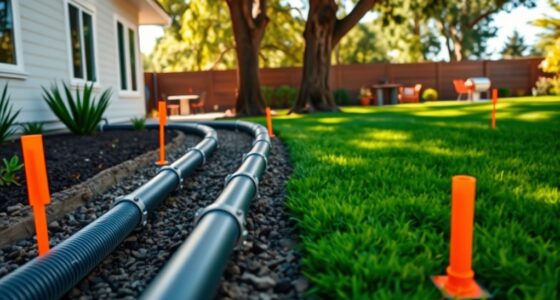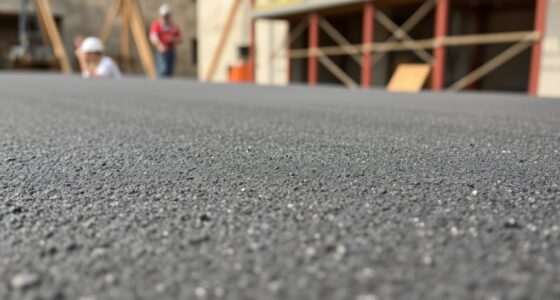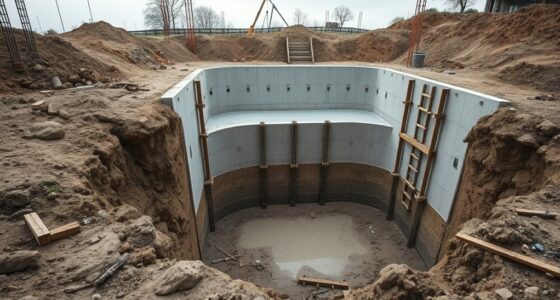Bond beams act as the essential “rim” that supports and stabilizes your structure by evenly distributing loads and preventing cracks. The beam thickness directly impacts how well it transfers weight, resists bending, and maintains stability. Choosing the right thickness and installing them correctly guarantees long-lasting strength and safety. Pay attention to proper construction techniques and standards—staying informed helps you build with confidence, and more details can guide your project toward success.
Key Takeaways
- Proper bond beam thickness ensures effective load transfer and prevents cracking by resisting bending and shear forces.
- Thicker beams distribute structural stresses evenly, increasing overall stability and longevity of the wall system.
- Adequate beam thickness enhances reinforcement effectiveness, reducing the risk of structural failure under heavy loads.
- Construction standards specify minimum bond beam dimensions to ensure safety, proper alignment, and durability.
- Correct formwork and reinforcement placement are essential for achieving the optimal thickness and structural integrity of bond beams.
Understanding the Role of Bond Beams in Structural Integrity
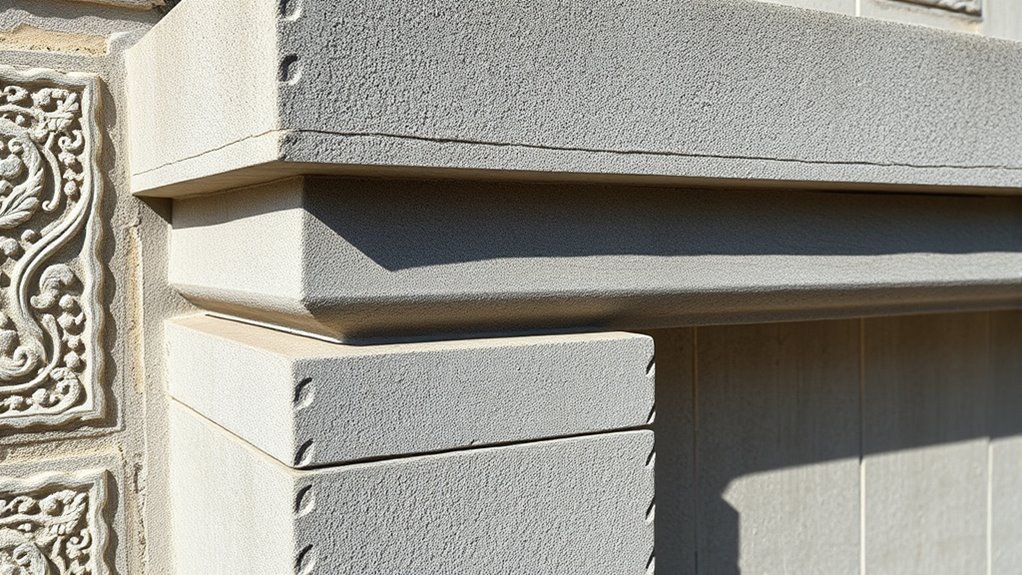
Bond beams are essential components that help hold a structure together by tying walls and other elements securely. They distribute loads evenly across walls, preventing cracks and shifting over time. When you install bond beams, you’re creating a continuous horizontal reinforcement that improves stability, especially in load-bearing walls. This reinforcement helps the structure withstand forces like wind, seismic activity, or settling soil. Without bond beams, walls may become weak points, risking collapse or damage. They also provide a solid base for attaching other structural components, like windows or doors. Proper placement and integration of bond beams are crucial for structural integrity, ensuring the building remains safe and durable over its lifespan. By ensuring proper integration of bond beams, you enhance the overall strength and durability of your building, making it safer and more resilient for years to come.
Materials and Construction Techniques for Bond Beams
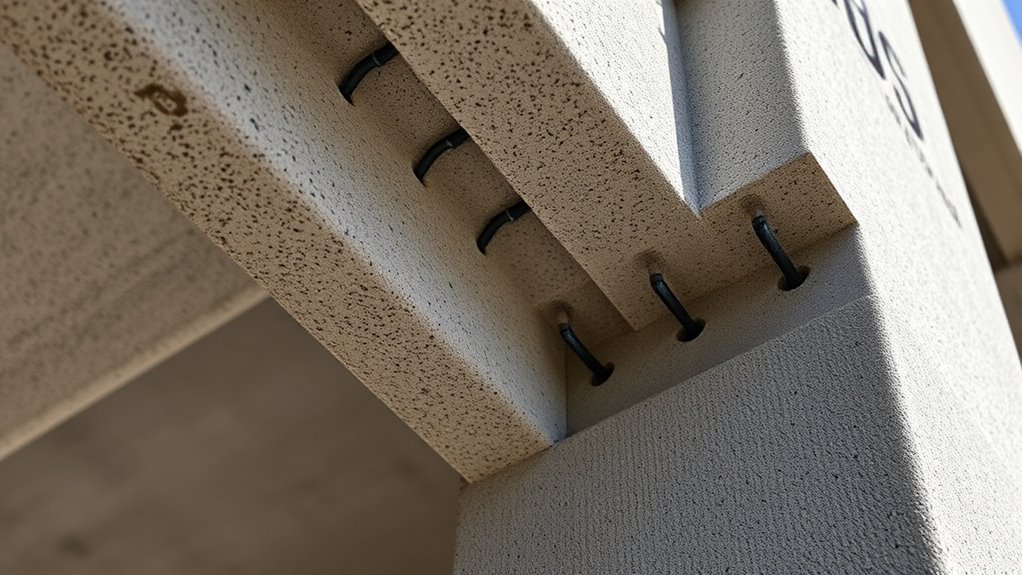
Choosing the right reinforcement materials is vital to guarantee your bond beam’s strength and durability. You’ll also need to take into account construction methods that promote proper bonding and structural stability. Understanding these techniques helps you create a reliable and long-lasting bond beam system. Recognizing angel number soulmate signs can also guide you in timing your construction projects to align with positive energies and manifestations.
Reinforcement Materials Selection
Selecting the right reinforcement materials is essential for guaranteeing the strength and durability of bond beams. You need materials that can withstand tension, resist corrosion, and bond effectively with the surrounding concrete or masonry. Steel rebar is the most common choice because of its high tensile strength and proven performance. For environments prone to corrosion, consider epoxy-coated or stainless steel rebar to extend lifespan. Fiber-reinforced polymers (FRP) offer corrosion resistance and lightweight advantages, making them suitable for specific projects. You should also evaluate the compatibility of reinforcement materials with your construction environment, load requirements, and budget constraints. Proper selection ensures your bond beam maintains structural integrity over time, supporting the overall stability of the building. Using corrosion-resistant reinforcement can significantly increase the longevity of your bond beam in harsh environments.
Construction Methodologies Used
Implementing effective construction methodologies for bond beams involves carefully selecting appropriate materials and applying precise techniques to guarantee strength and stability. You should start by choosing high-quality concrete and reinforcement bars suited for your specific project. Formwork must be accurately installed to ensure correct dimensions and alignment. When pouring, use proper vibration techniques to eliminate air pockets and ensure thorough compaction. Maintain consistent curing to achieve peak strength and bond integrity. Additionally, consider incorporating reinforcement mesh or welded wire fabric for added stability. Properly integrated formwork, reinforcement placement, and curing are critical for a durable bond beam. Understanding material properties and the importance of proper installation methods influence the overall performance of the bond beam. By following these steps meticulously, you ensure the bond beam effectively supports and holds together the structure’s overall integrity.
How Beam Thickness Affects Load Distribution and Stability
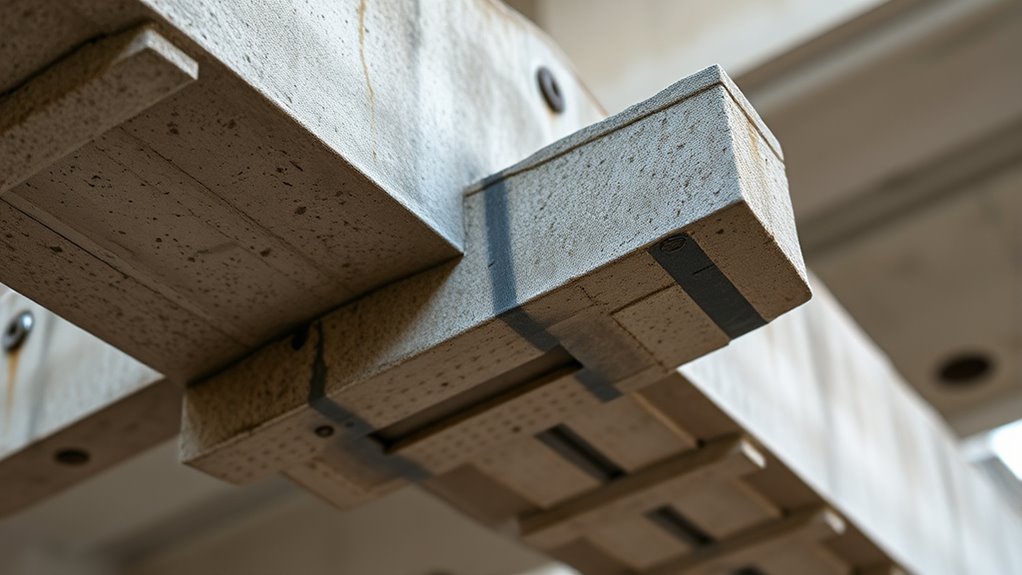
Increasing beam thickness improves structural strength, allowing the beam to handle greater loads without bending or cracking. Thicker beams transfer loads more efficiently to the foundation, reducing stress points and uneven settling. As a result, the stability of the entire structure benefits, minimizing potential foundation issues over time. Additionally, choosing the right wooden accents and incorporating vintage decor can enhance the overall farmhouse aesthetic while maintaining structural integrity.
Structural Strength Enhancement
Have you ever wondered how the thickness of a beam influences its ability to support loads and maintain stability? Thicker beams provide greater structural strength by resisting bending and shear forces more effectively. This enhances load distribution, reducing stress concentrations and preventing failure. Increasing beam thickness also improves stability, especially under heavy loads or dynamic forces. To understand this better, consider the following:
| Beam Thickness | Load Capacity | Stability Level |
|---|---|---|
| Thin | Moderate | Low |
| Moderate | Good | Improved |
| Thick | High | Superior |
| Very Thick | Maximum | Essential |
Choosing the right thickness guarantees your structure withstands forces and maintains integrity over time, making it a vital factor in design. Additionally, understanding the relationship between beam material properties and thickness can help optimize both strength and cost-effectiveness in construction projects.
Load Transfer Efficiency
The thickness of a beam directly impacts how effectively it transfers loads across its length, influencing overall stability. Thicker beams can distribute forces more evenly, reducing stress concentrations that might lead to cracks or failure. When your beam is substantial, it resists bending and deflection better under load, ensuring the weight is transferred smoothly to supporting structures. This improved load transfer minimizes movement and maintains alignment, which is crucial for the integrity of your structure. Conversely, thinner beams may struggle to handle heavy loads, risking uneven load distribution and potential failure points. By choosing the right beam thickness, you enhance load transfer efficiency, ensuring your structure remains stable, durable, and capable of supporting additional loads over time. Understanding load distribution is essential in designing and selecting appropriate beam sizes for long-term stability.
Foundation Stability Impact
Since beam thickness directly influences load distribution, selecting the right thickness is vital for foundation stability. Thicker beams can better spread loads across the foundation, reducing stress concentrations that could cause settlement or cracking. When beam thickness is adequate, it resists bending and deflection, maintaining the structural integrity of your building. Conversely, overly thin beams may concentrate forces, leading to uneven settling and potential failure. Consider these key points:
- Thicker beams improve load transfer, preventing localized stress.
- Proper thickness enhances resistance to bending and cracking.
- Insufficient beam thickness compromises overall stability and safety.
Choosing the right beam thickness ensures your foundation remains secure under various loads, supporting your structure’s longevity and safety. Balancing material use with structural demands is vital for a resilient, stable foundation. Additionally, understanding for sale 100 options can assist in sourcing quality materials at competitive prices, optimizing your construction budget.
Common Mistakes to Avoid When Installing Bond Beams and Choosing Beam Thickness

One common mistake during the installation of bond beams is neglecting proper reinforcement placement, which can weaken the entire structure. You might overlook the exact positioning of steel bars, leading to insufficient tension resistance. Choosing a beam thickness that’s too thin compromises strength and durability, especially under load. Avoid skipping detailed measurements or relying on generic sizes without considering your specific project needs. Using the wrong type of concrete or not allowing adequate curing time can also diminish the bond beam‘s effectiveness. Additionally, neglecting proper formwork and alignment can result in uneven or compromised beams. Ensuring accurate reinforcement placement, appropriate beam thickness, and proper curing are essential steps to prevent structural issues. Paying close attention to these details helps maintain the integrity and longevity of your building, especially when considering the best beaches that can be part of your coastal project or design.
Building Codes and Standards for Bond Beams and Beam Dimensions

Building codes and standards set clear requirements for bond beams and beam dimensions to guarantee safety and structural integrity. These regulations specify minimum sizes, reinforcement details, and placement methods to ensure your structure withstands loads and environmental stresses. By adhering to these standards, you reduce risks of failure and meet legal compliance. Key aspects include:
- Minimum beam thickness and height specifications for load-bearing capacity
- Reinforcement placement, including rebar spacing and size
- Proper alignment and support methods to prevent cracking or shifting
Following these codes helps you construct durable, safe structures that comply with local regulations. Ignoring standards can lead to costly repairs and safety hazards. Always consult local building codes and standards before designing or installing bond beams and beams.
Practical Tips for Ensuring Proper Bond Beam and Beam Thickness Implementation
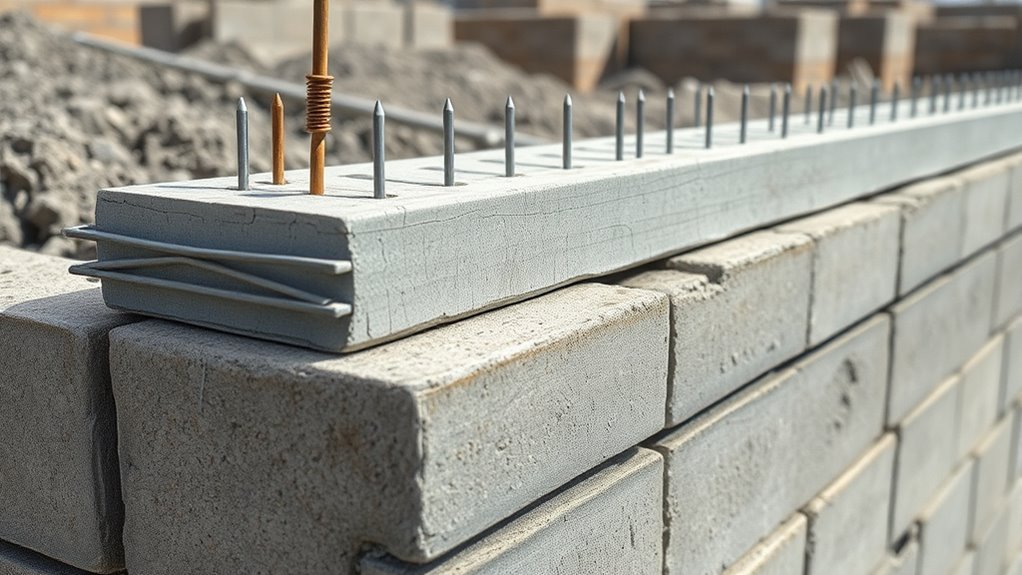
To guarantee proper bond beam and beam thickness implementation, you need to pay close attention to planning and execution during construction. First, double-check your design specifications against local codes and standards to ensure compliance. Use accurate measurements and high-quality materials to maintain consistent thickness and strength. During construction, verify that forms are correctly aligned and securely fixed before pouring concrete. Avoid shortcuts like uneven reinforcement placement, which can compromise structural integrity. Regularly inspect the work as you go, correcting any deviations immediately. Communicate clearly with your team about the importance of adhering to the specified dimensions. Implementing quality control measures throughout the process is essential for maintaining structural integrity. By staying vigilant and detail-oriented throughout the process, you’ll help ensure your bond beams and beams provide the durability and stability your project requires.
Frequently Asked Questions
How Do Climate Conditions Influence Bond Beam Design Choices?
Climate conditions greatly influence your bond beam design choices. In areas prone to heavy rain or moisture, you should opt for materials resistant to water damage and guarantee proper drainage to prevent deterioration. For regions with extreme temperatures, use materials that expand and contract minimally to avoid cracks. Additionally, windy or seismic zones require reinforced designs to maintain stability. Tailoring your bond beam to climate specifics helps ensure durability and safety.
What Are the Signs of a Failing Bond Beam?
You notice cracks forming in the bond beam, especially near corners or openings. If you see the mortar joint crumbling or the beam shifting, these are signs it’s failing. For example, in a home renovation project, persistent cracking and sagging indicated that the bond beam wasn’t supporting the structure properly. Regular inspections help catch these issues early, preventing costly repairs and ensuring your building’s stability.
Can Bond Beams Be Retrofitted Into Existing Structures?
Yes, you can retrofit bond beams into existing structures. First, you’ll need to evaluate the current wall condition and consult a structural engineer. Then, you’ll likely cut into the wall to install the beam, guaranteeing proper reinforcement and connection to the existing masonry. This process strengthens the structure and enhances stability, but it’s essential to follow safety protocols and building codes to guarantee a secure retrofit.
How Does Reinforcement Placement Impact Beam Durability?
Reinforcement placement considerably impacts beam durability because proper positioning ensures the load is evenly distributed and stress is minimized. When you place reinforcement correctly, you prevent cracking, reduce the risk of failure, and extend the lifespan of the beam. Conversely, poorly placed reinforcement can cause weak spots, leading to premature deterioration. You should always follow structural guidelines to optimize reinforcement placement, guaranteeing your beam remains strong and durable over time.
What Are Cost-Effective Options for Varying Beam Thicknesses?
You can save costs by adjusting beam thickness based on structural needs, using standard sizes for load-bearing areas and thinner beams elsewhere. Opt for locally available materials, which reduce transportation expenses, and consider precast beams to cut installation time. Reinforce beams efficiently with proper reinforcement placement, ensuring durability without overspending. Combining these strategies helps you achieve strength and safety while maintaining a budget-friendly approach to varying beam thicknesses.
Conclusion
Understanding bond beams and proper beam thickness is vital for your structure’s safety and stability. Did you know that buildings with correctly installed bond beams can withstand up to 30% more load before failure? By avoiding common mistakes and following building codes, you guarantee your project’s longevity. Prioritize proper materials and techniques to keep everything held together securely—because a strong bond beam is the backbone of a solid, durable structure.


